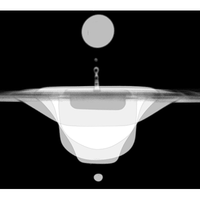水滴撞击产生的气泡:表面张力和粘度的综合效应
IF 2.5
3区 物理与天体物理
Q2 PHYSICS, FLUIDS & PLASMAS
引用次数: 0
摘要
在本研究中,我们系统地研究了表面张力对捏合状态下液滴撞击后气泡夹带的影响。实验使用了三种不同的系统:纯水、含乙醇的水溶液或含表面活性剂分子的水溶液,两种溶液的浓度各不相同。在所有溶液中,空腔的发展动态都表现出相似性,并有效地用无量纲重力-毛细管参数来表征。无论表面张力如何,我们的测量结果表明,只有 40% 的冲击能转化为空腔势能。然而,在考虑气泡夹带时,出现了一个显著的区别。我们绘制了(U,γ)平面上的气泡图,并观察到在水-乙醇混合物中,气泡夹带的条件随着表面张力的变化而改变。更有趣的是,这些条件在表面活性剂溶液中的变化方式截然不同。为了解释我们的实验发现,我们汇编了文献中的一整套实验和数值结果。我们证明了通过包括表面张力和粘度影响在内的经验法则统一所有体系和水乙醇混合物结果的可能性。尽管现阶段还不存在物理上的合理解释,但这一经验法则表明,毛细管波沿着空腔界面传播在气泡夹持中起着重要作用。在此背景下,考虑到表面活性剂分子赋予界面的弹性特性,含表面活性剂溶液的行为与其他均相溶液一致。本文章由计算机程序翻译,如有差异,请以英文原文为准。

Bubble entrapment by drop impact: Combined effect of surface tension and viscosity
In this study, we systematically investigate the effect of surface tension on bubble entrapment after drop impact in the pinching regime. Experiments are conducted using three different systems: pure water, aqueous solutions with ethanol, or with surfactant molecules, both at various concentrations. Results are compiled for a large set of values of the surface tension and the drop impact velocity . Across all solutions, the cavity development dynamics exhibit similarity and are effectively characterized by dimensionless gravito-capillary parameters. Whatever the surface tension, our measurements indicate that only of the impact energy is converted into potential energy of the cavity. However, a notable distinction arises when considering bubble entrapment. We have constructed a bubbling diagram in the () plane, and observed that the conditions for bubble entrapment are altered with changing surface tension in water-ethanol mixtures. More intriguingly, these conditions are modified in a distinctly different manner for surfactant solutions. To interpret our experimental findings, we compile a comprehensive set of experimental and numerical results from the literature. We demonstrate the possibility of unifying results across all systems and our water-ethanol mixtures through an empirical law including the influence of surface tension and viscosity. Although no physical justification exists at this stage, this empirical law suggests the significant role of capillary waves traveling along the cavity interface in bubble entrapment. Within this context, the behavior of surfactant-laden solutions aligns with other homogeneous solutions by considering the elastic properties conferred upon the interfaces by surfactant molecules.
求助全文
通过发布文献求助,成功后即可免费获取论文全文。
去求助
来源期刊

Physical Review Fluids
Chemical Engineering-Fluid Flow and Transfer Processes
CiteScore
5.10
自引率
11.10%
发文量
488
期刊介绍:
Physical Review Fluids is APS’s newest online-only journal dedicated to publishing innovative research that will significantly advance the fundamental understanding of fluid dynamics. Physical Review Fluids expands the scope of the APS journals to include additional areas of fluid dynamics research, complements the existing Physical Review collection, and maintains the same quality and reputation that authors and subscribers expect from APS. The journal is published with the endorsement of the APS Division of Fluid Dynamics.
 求助内容:
求助内容: 应助结果提醒方式:
应助结果提醒方式:


